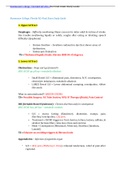Rasmussen College, FloridaNURSING 2N2-Final-Exam-Study-Guide
Rasmussen College, Florida N2-Final Exam Study Guide
1. Upper GI Tract
Dysphagia – Difficulty swallowing. Major concern for older adult & victims of stroke.
Has trouble swallowing liquids or solids, coughs after eating or drinking, speech
difficulty (dysphonia)
• Barium Swallow – Swallows radioactive dye that shows areas of
dysfunction.
• Endoscopic Evaluation
TX = Thickened liquids/foods. Elevate HOB 30-45 degrees.
2. Lower GI Tract
Obstruction – Poop can’t go forward .
ABG: HCO3 up, pH up = metabolic alkalosis
• Small Bowel S/S = Abdominal pain, distention, N/V, constipation,
electrolyte imbalances, metabolic alkalosis
• LARGE Bowel S/S = Lower abdominal cramping, constipation, ribbon
like stools.
What is contraindicated?! BARIUM ENEMA
TX= Possible Surgery, NG Tube Suction, NPO, IV Therapy (fluids), Pain Control
IBS (Irritable Bowel Syndrome) – Chronic diarrhea and/or constipation
ABG: HCO3 low, pH low – metabolic acidosis
•S/S = excess farting (flatulence), distention, cramps, pain,
diarrhea/constipation, LLQ pain.
• Treatment = AVOID triggers or fruit, berries, lettuce, lactose, caffeine, &
alcohol. Increase fiber, relax, less stress, and exercise
• Meds = Constipation (Metamucil, Fibercon), Diarrhea (Imodium,
Lomotil)
TX = Educate on avoiding triggers & fibrous foods
Appendicitis – Infection of appendix organ
• S/S = RLQ pain (McBurney’s Point), rebound tenderness, relief of pain after
ruptured.
,Rasmussen College, FloridaNURSING 2N2-Final-Exam-Study-Guide
o RUPTURED = think infection… chills, increased WBC, guarding,
distention, shallow breathing, irritability, & restlessness.
TX = Surgical removal, semi-fowler RIGHT side lying, no heat, no laxatives, cold
compress
Ulcerative Colitis – Inflammation of mucosa in colon & rectum.
ABG: HCO3 low, pH low = metabolic acidosis
• S/S = > 10 liquid stools per day, abdominal pain, dehydration, tachycardia,
anemia, distention.
o Complications = hemorrhage, abscess, TOXIC MEGACOLON,
obstruction, perforation
Meds - sulfasalazine (Azulfidine), mesalamine (Asocol), azathioprine (Imuran) to
alter immune response; antidiarrheal for symptom management
TX = Avoid trigger foods, may require NPO & TPN treatment
Chohn’s Disease – inflammation of mucosa in terminal ilium
ABG: HCO3 low, pH low = metabolic acidosis
• S/S = diarrhea 5-6x daily, abdominal pain, low-grade fever, weight loss,
electrolyte imbalance.
TX = High calorie, high protein, antidiarrheal, corticosteroids,
immunomodulators, TPN during exacerbation (promotes rest)
Diverticulitis – Inflammation of the sac-like pouches known as diverticula in the
colon.
• S/S = changing from constipation to diarrhea constantly, LLQ pain
o Perforation = fever, chills, tachycardia, gen. abdominal pain
TX = Dietary modifications, colon resection, antibiotics, pain relief, stool
softeners. Educate on low Fiber diet & avoid nuts!
3. Urinary Dysfunction
• Stress incontinence: loss of urine with increased abdominal pressure
• Reflex incontinence: involuntary loss of urine at somewhat predictable
intervals when a specific bladder volume is reached
• Urge incontinence: involuntary passage of urine soon after strong urge to
void
• Functional incontinence: involuntary, unpredictable passage of urine
,Rasmussen College, FloridaNURSING 2N2-Final-Exam-Study-Guide
• Total incontinence: continuous and unpredictable loss of urine
UTI – Inflammation of bladder, ureters, or urethra.
Cystitis = infection of bladder (lower)
Pyelonephritis = Infection of kidneys (upper)
Most commonly caused by…. E. Coli
• S/S = frequency, urgency, dysuria, low back pain, nocturia, incont. Hematuria,
retention
• Older adults = confusion, no appetite, frequent falling.
TX – Antibiotics, increase fluid to 3L/day, antispasmodics
Urinary Tract Calculi (Urolithiasis) – Calculi stone formed in the urinary tract
Nephrolithiasis – Kidney Stone
Calcium Phosphate is the most common type of kidney stone
• S/S – severe pain, flank pain radiating to groin, distention, fever, & chills
Main Cause: DEHYDRATION = Prevent by drinking fluids
TX – Stones 5mm or smaller usually pass on their own. Stones greater than
5mm diameter require surgery. Monitor renal function, strain urine, diuretics
may be orders, FLUIDS.
Educate – Diet, increase fluid intake, report signs of UTI, report increased pain.
, Rasmussen College, FloridaNURSING 2N2-Final-Exam-Study-Guide
Pyelonephritis – Infection of kidneys
Most commonly caused by E.Coli
• S/S – hematuria, urinary frequency, dysuria, flank pain, costovertebral
tenderness, tachypnea, GI symptoms, muscle tenderness
TX – Antibiotics for specific organism, increase fluid intake to 3L/day,
antispasmodics for bladder spasms
Glomerulonephritis – Inflammation of capillary loops in glomeruli of kidney that
typically follows an infection of A-beta-hemolytic streptococcus.
• S/S – Pharyngitis, fever, malaise, weakness, fatigue (early signs), anorexia,
nausea, vomiting, peripheral edema, hypertension, hypoalbuminemia.
• Recent URI, UTI, pericarditis, or skin infection
• Labs may reveal increased BUN & Creatinine, hyponatremia, hyperkalemia,
hypophosphatemia.
TX – Antimicrobials (Penicillin’s), pain relief, electrolyte replacement, strict
I&O.
Urinary Retention – Bladder is not emptying all of the way and urine is staying.
• Causes – Benign prostatic hyperplasia, surgery, anticholinergic,
antidepressants, antipsychotics, antiparkinsonian, and antihypertensive
• S/S – fluid intake larger than output, inability to void, frequently voiding
small amounts, bladder distention, suprapubic discomfort, restlessness
TX – Monitor I&O’s, facilitate voiding, catheterization as needed, possible
surgery, cholinergic medications




